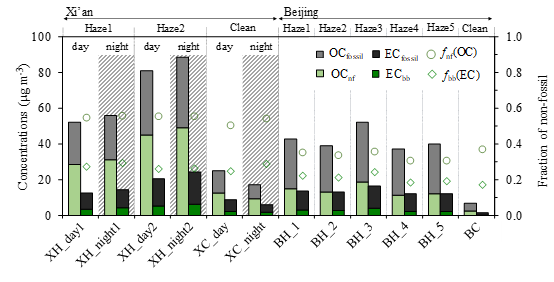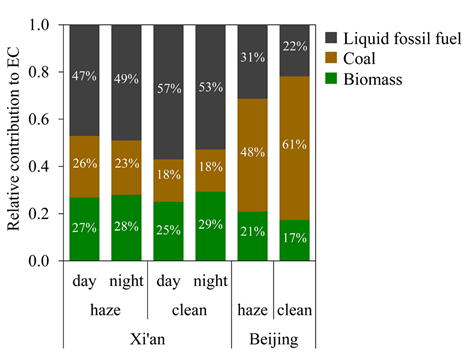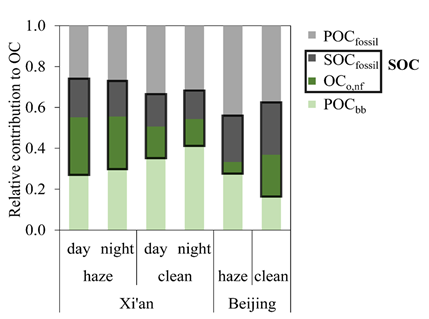Ni, H., Huang, R.-J.*, Cosijn, M. M., Yang, L., Guo, J., Cao, J., and Dusek, U.: Measurement report: dual-carbon isotopic characterization of carbonaceous aerosol reveals different primary and secondary sources in Beijing and Xi'an during severe haze events, Atmos. Chem. Phys., 20, 16041–16053, https://doi.org/10.5194/acp-20-16041-2020, 2020.
To mitigate haze pollution in China, a better understanding of the sources of carbonaceous aerosols is required due to the complexity in multiple emissions and atmospheric processes. A research group led by Prof. HUANG Rujin from the Institute of Earth Environment (IEE) of the Chinese Academy of Sciences, investigated the sources of carbonaceous aerosol using a dual-carbon isotopic approach for PM2.5 samples collected in urban Xi'an and Beijing that reached the red alarm level during December 2016 and January 2017.
The 14C results showed that fossil sources dominated EC, contributing 71-75% of EC in Xi'an and 76-83% of EC in Beijing. The remaining EC was attributed to biomass burning (Figure 1). In Beijing, coal combustion was the dominant fossil source of EC with a decreasing contribution to EC from clean periods (∼ 61 %) to haze periods (∼ 48 %). In Xi'an, liquid fossil fuel combustion contributed 44 %–49 % of EC during haze periods and 54 %–57 % of EC during clean periods (Figure 2).
The 14C measurements of OC showed that the contribution of non-fossil sources to OC was larger than that to EC and was on average 54 ± 2 % in Xi'an and 34 ± 3 % in Beijing (Figure 1). In Xi'an, the fraction of SOC in total OC was larger during haze periods than during clean periods mainly due to increased SOC from non-fossil sources (Figure 3). Beijing showed the opposite trends with a larger fraction of SOC in total OC during clean periods than during haze periods mainly due to the elevated contribution from non-fossil SOC during clean periods.
SOC was dominated by non-fossil sources in Xi'an but by fossil sources in Beijing, especially during haze periods. In Xi'an, a slight day–night difference was found during clean periods with increasing fossil contribution to OC and EC during the day and less SOC at night. During strong haze, this day–night difference was negligible, suggesting a large accumulation under stagnant weather conditions during the severe haze periods.
This research has been supported by the National Key Research and Development Program of China (grant no. 2017YFC0212701), the National Natural Science Foundation of China (grant nos. 41925015, 91644219, and 41877408), the KNAW (grant no. 530-5CDP30), the Chinese Academy of Sciences (grant no. ZDBS-LY-DQC001), and the Cross Innovative Team fund from the State Key Laboratory of Loess and Quaternary Geology (grant no. SKLLQGTD1801).
This study, published in Atmospheric Chemistry and Physics (https://doi.org/10.5194/acp-20-16041-2020), present 14C- and 13C-based source apportionment of carbonaceous aerosol during severe winter haze events in Beijing and Xi’an, China. The resulting source apportionment of elemental carbon and organic carbon in haze-day vs. clean-day and day-time vs. night-time samples improve our knowledge and understanding of sources and formation of carbonaceous aerosols. The Findings from this study provide better insights into the main aerosol sources and formation mechanisms in polluted regions.

Figure 1. Mass concentrations of OC and EC from fossil and non-fossil sources (OCfossil, OCnf, ECfossil, and ECbb), as well as fraction of non-fossil carbon in OC and EC (fnf(OC) and fbb(EC), respectively), for daytime and nighttime PM2.5 samples in Xi'an and 24 h integrated PM2.5 samples in Beijing during haze and clean periods during the measurement periods (2 December 2016 to 10 January 2017).

Figure 2. Fractional contributions of three combustion sources to EC during haze and clean periods in Xi'an and Beijing.

Figure 3. Averaged fractions of POCbb, OCo,nf, POCfossil, and SOCfossil in total OC during haze and clean periods in Xi'an and Beijing, China.

